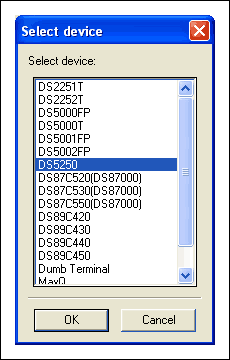Introduction This application note describes the setup of the DS5250 safety microcontroller evaluation (EV) board (to purchase this evaluation board, please send an email to var name = "micro.support @"; var domain = "maxim-ic.com" ; document.write ("" + name + domain + ""); micro. (English only). This article describes how to use the library file of the microcontroller to generate the RSA key.
The evaluation board includes a DS5250 microcontroller, 1MB battery backup SRAM, 1MB flash memory and voltage regulator, two DB-9 serial port connectors, and switches and LEDs for controlling and displaying the working status of the circuit board. Add a power supply and RS-232 cable connected to a personal computer, you can get a fully functional DS5250 evaluation system.
Generating RSA key To obtain the binary code (rsa.hex) and program code used to generate the RSA key routine, please send an email to: var name = "micro.support @"; var domain = "maxim-ic. com "; document.write (" "+ name + domain +" "); micro. (English only). Follow the instructions below to load and run the program for the DS5250-KIT evaluation board loading application routine.
To install and run the C language application program that generates the RSA key, use Keil µVision2 IDE. Install Keil µVision2 IDE. Open the project rsa.uv2 and send an email to: var name = "micro.support @"; var domain = "maxim-ic.com"; document.write ("" + name + domain + ""); micro. (English only) Project files and program codes can be requested. Click Project
 Rebuild All Target FILES produces rsa.hex file. Load application routines for the DS5250-KIT evaluation board. Use the Microcontroller Toolbox (MTK) to load the application to the evaluation board. The latest version of the MTK application software can be downloaded from the website: http://files.dalsemi.com/pub/ microcontroller / dev_tool_software / mtk /. Install MTK, run the installation file and follow the instructions. After the installation is complete, a new option will be added to the menu: Start
Rebuild All Target FILES produces rsa.hex file. Load application routines for the DS5250-KIT evaluation board. Use the Microcontroller Toolbox (MTK) to load the application to the evaluation board. The latest version of the MTK application software can be downloaded from the website: http://files.dalsemi.com/pub/ microcontroller / dev_tool_software / mtk /. Install MTK, run the installation file and follow the instructions. After the installation is complete, a new option will be added to the menu: Start  All Programs
All Programs  Dallas Semiconductor MTK. After running MTK, you can see a dialog box similar to Figure 1.
Dallas Semiconductor MTK. After running MTK, you can see a dialog box similar to Figure 1. If you encounter technical problems while running MTK, you may be able to find corresponding answers in the Maxim discussion group. You can find answers on the current forum or submit your questions to the forum: Maxim discussion group (English only).

Figure 1. MTK options at startup
Select the DS5250 option to communicate with the evaluation board. From the MTK menu, OpTIons
 Configure Serial Port, select the COM port you are using and select 115200 data rate. Then select Target
Configure Serial Port, select the COM port you are using and select 115200 data rate. Then select Target  Open COMx port at 115200 baud option and Target
Open COMx port at 115200 baud option and Target  Connect to Loader to reset the evaluation board. The DS5250 loader should output the following similar information: DS5250 SECURE LOADER VERSION 1.0 COPYRIGHT (C) 2002 DALLAS SEMICONDUCTOR LID: 62E9490700000071 8284> Send the following command to the loader to configure the memory of the evaluation board: W MSIZE 12 * ¹ W MCON 81² ¹W MSIZE 12 defines the size of the external program and data memory as 512Kb.
Connect to Loader to reset the evaluation board. The DS5250 loader should output the following similar information: DS5250 SECURE LOADER VERSION 1.0 COPYRIGHT (C) 2002 DALLAS SEMICONDUCTOR LID: 62E9490700000071 8284> Send the following command to the loader to configure the memory of the evaluation board: W MSIZE 12 * ¹ W MCON 81² ¹W MSIZE 12 defines the size of the external program and data memory as 512Kb. ¹W MCON 81 defines memory as partition mode.
From the File menu, select Load HEX File, and then select the rsa.hex file created.
Select Target
 Disconnect from Loader loads the program to the evaluation board, and the prompt information is shown in Figure 2.
Disconnect from Loader loads the program to the evaluation board, and the prompt information is shown in Figure 2. Enter the bit length of the key to be generated:
Enter the number (for example, 1024) and wait for the display result. The running status of the application is shown in Figure 2. It takes about 60 seconds to generate a 1024-bit RSA key to encrypt and decrypt random information. Each run time may be different. Table 1 lists the minimum, maximum, and average time required to generate an RSA key with a different bit length.

Figure 2. Execution status and results of application routines
Using the RSA keystore file to develop a simple application library file provides four simple and easy-to-use C interface functions for generating keys or using private / public keys to encrypt / decrypt user information. Please refer to the rsalib.h file to view the prototype design of these interfaces. The design examples provided in this application note are used to illustrate the use of these interface functions:
rsa_generateKeySet (...) rsa_bignumModExp (...) rsa_newNum () rsa_freeNum () The following gives typical test results under different bit lengths.
Table 1. Average time required to generate RSA keys
| RSA Bit Length Generated | Number of Tests Run | Minimum TIme Taken for the Test (in seconds) | Maximum TIme Taken for the Test (in seconds) | Average TIme Taken per Test (in seconds) |
| 256 | 60 | 3.4 | 10.3 | 4.8 |
| 512 | 60 | 6.1 | 21.0 | 10.76 |
| 1024 | 60 | 13.5 | 62.0 | 26.6 |
| 2048 | 60 | 36.6 | 313.2 | 122.4 |
| 3072 | 30 | 102.7 | 731.9 | 369.8 |
Conclusion The library file provided by Maxim for generating RSA keys enables the C program to evaluate the hardware functions and performance of the DS5250 microcontroller, and the generated RSA keys can reach 4095 bits.
Porcelain Station Post Insulator according to IEC, ANSI and other standards are used in substations and related switching equipment. Station Post Ceramic Insulator are produced in single piece up to 2300 mm and can operate voltages up to 1100KV in stacked configuration. High Voltage Station Post Insulator are subjected to compression, cantilever and torsional loads during service. Station Post Insulator for high voltagr use semiconductor glazes, so you don't have to worry about salt deposits or corona discharges.
Product Description
1.Material: Porcelain
2.Improved contamination performance
3.Widely applied to the line of different voltage classes
4.With features of good insulation performance
5.Long lasting durability
| MAIN DIMENSIONS AND STANDARD PARTICULARS | |
| Type | C4-125 |
| Creepage distance(mm) | 430 |
| Dry arcing distance(mm) | 200 |
| Cantilever strength(KN) | 4 |
| Tension Strength(KN) | 38 |
| Torsion strength(N.m) | 800 |
| Power frequency flashover wet voltage(KV) | 50 |
| Impulse withstand voltage(KV) | 125 |
| Net weight(KG) | 9 |
| MAIN DIMENSIONS AND STANDARD PARTICULARS | |||
| ANSI Class | TR-205 | TR-208 | TR-210 |
| Creepage Distance/mm | 394 | 610 | 940 |
| Cantilever Strength/kn | 8.9 | 8.9 | 8.9 |
| Tensile Strength/kn | 38 | 44.5 | 53 |
| Torsional Strength/k.m | 791 | 904 | 1130 |
| Compression Strength/kn | 44.5 | 44.5 | 66.7 |
| Low Frequency Dry Flashover Voltage/kv | 85 | 110 | 145 |
| Low Frequency Wet Flashover Voltage/kv | 55 | 75 | 100 |
| Critical Impulse Flashover Voltage, Pos/kv | 125 | 170 | 225 |
| Critical Impulse Flashover Voltage, Neg/kv | 200 | 250 | 290 |
| Low Frequency Dry Withstand Voltage/kv | 50 | 70 | 95 |
| Low Frequency Wet Withstand Voltage/kv | 45 | 60 | 80 |
| Impulse Withstand Voltage/kv | 110 | 150 | 200 |
| Net Weight/kg | 7 | 11 | 16 |
| Applicable Standard | ANSI C29.9 | ANSI C29.9 | ANSI C29.9 |


We warmly welcome friends both domestic and abroad to visit our company, if you have any questions, please contact with us directly.
Station Post Insulator
Station Post Insulator,Station Post Ceramic Insulator,High Voltage Station Post Insulator,Post Insulator For High Voltage
FUZHOU SINGREE IMP.& EXP.CO.,LTD. , https://www.cninsulators.com